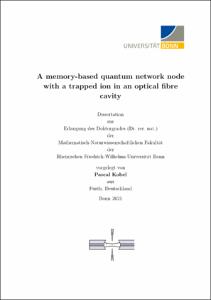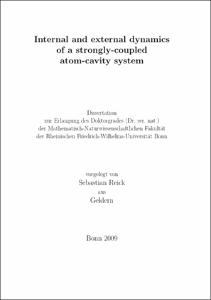Control of Atoms in a High–Bandwidth Cavity for Quantum Nodes

Control of Atoms in a High–Bandwidth Cavity for Quantum Nodes

| dc.contributor.advisor | Meschede, Dieter | |
| dc.contributor.author | Uruñuela Castillero, José Eduardo | |
| dc.date.accessioned | 2023-02-13T09:06:14Z | |
| dc.date.available | 2023-02-13T09:06:14Z | |
| dc.date.issued | 13.02.2023 | |
| dc.identifier.uri | https://hdl.handle.net/20.500.11811/10638 | |
| dc.description.abstract | Optical cavities with coupled atoms are a promising platform as the nodes of future quantum networks, enabling interchange of information between single atoms and single photons. In particular, fiber-based high-bandwidth cavities offer convenient and efficient routing of quantum information, in an interesting regime that combines strong coupling with the atom and high-rate information exchange with the quantum channel. However, critical control of coupled atoms for the quantum node operation, is hindered by the strong Purcell effect, the miniaturized geometry and the high-bandwidth property of such cavities.
In this thesis, I report on my contributions towards a high level of control of individual atoms coupled to a high-bandwidth cavity. To this end, three new experimental techniques were developed specially adapted to high-bandwidth fiber cavities, with the following specific goals: (i) intracavity ground-state cooling of single atoms; (ii) atom position detection by fluorescence imaging independent from the cavity transition; (iii) cavity loading of small atomic ensembles with increased density. In the first part of this work, I present the experimental setup, consisting of a fiber Fabry-Pérot cavity (FFPC) coupled to Rb-87 atoms, and the necessary experimental apparatus to operate the system in a stable manner. I start by motivating the advantage of high-bandwidth cavities with a brief discussion on cavity-mediated light-matter interfacing, and the peculiar strong coupling regime. Then, I give an overview of the complete system with emphasis on the recent technical upgrades, such as an improved cavity stabilization, an upgraded Raman laser setup with a linewidth-reduced DBR laser, and a new cavity-compatible imaging system. Lastly, I introduce the basic experimental toolbox for atomic control that we employ to operate the atom-cavity module: (i) cavity-based atom detection; (ii) cooling with a magneto-optical trap (MOT) and trapping with a 3D lattice; (iii) state initialization by optical pumping; (iv) Raman hyperfine manipulation; (v) position detection by imaging. Most of my work was to extend such basic toolbox for an improved atomic control, with the techniques presented in the next chapters. In Chapter 3, I report successful cooling of a single Rb-87 atom to its one-dimensional motional ground state while coupled to the FFPC, by degenerate Raman sideband cooling (dRSC). We overcome the challenge of cooling in such high-bandwidth atom-cavity modules, by adapting the degenerate dRSC technique to our cavity and lattice geometry. Raman cooling transitions are driven by the trapping lattice and repumping by the intracavity probe field, without the need of additional lasers and activated by the magnetic bias field. The resource-efficient and simple implementation is a highlight. In Chapter 4, I present a newly implemented method in our system for successful fluorescence imaging of small atomic ensembles coupled to a high-bandwidth FFPC, that overcomes the inhibiting Purcell effect and the restricted optical access. It is based on techniques from the field of quantum gas microscopes and relies on the detection of repumper fluorescence on the D1 line generated by three-dimensional (3D) continuous Raman sideband cooling (cRSC). Thus, it remains fully independent from the cavity on the D2 line, for simultaneous operation of the atom-cavity node and position detection of the atoms. It requires only a single free-space beam together with intra-cavity fields, ideal for platforms with limited optical access, e.g. miniaturized quantum optical devices. The repumper-induced differential light shifts and the heating by dipole-force fluctuations (DFFs) are also analyzed. In Chapter 5, I introduce a novel and simple method to load the intracavity lattice: the drive-through loading. It only relies on the dynamic control of intensity and phase of one lattice arm that works as a conveyor belt between the MOT and the intracavity lattice. I discuss the working principle of the technique, demonstrate that its efficiency, and show its tuning capability of the cavity-coupled atom number. In the last chapter, I summarize the advances presented here that extend the toolbox for control and manipulation of atom-cavity systems, impacting in the development of quantum networks. The three new techniques presented here, with a future implementation of single-atom addressing, pave the way for creating atomic arrays with predefined number and positions in the cavity: a cavity-quantum register. | en |
| dc.language.iso | eng | |
| dc.rights | Namensnennung 4.0 International | |
| dc.rights.uri | http://creativecommons.org/licenses/by/4.0/ | |
| dc.subject | experimental physics | |
| dc.subject | atomic physics | |
| dc.subject | AMO | |
| dc.subject | quantum optics | |
| dc.subject | quantum repeater | |
| dc.subject | quantum node | |
| dc.subject | quantum networks | |
| dc.subject | cavity QED | |
| dc.subject | CQED | |
| dc.subject | fiber cavity | |
| dc.subject | FFPC | |
| dc.subject | single atom control | |
| dc.subject | optical lattices | |
| dc.subject | Raman imaging | |
| dc.subject | Raman cooling | |
| dc.subject | Purcell effect | |
| dc.subject | high-bandwidth optical cavity | |
| dc.subject | Rubidium | |
| dc.subject.ddc | 530 Physik | |
| dc.title | Control of Atoms in a High–Bandwidth Cavity for Quantum Nodes | |
| dc.type | Dissertation oder Habilitation | |
| dc.publisher.name | Universitäts- und Landesbibliothek Bonn | |
| dc.publisher.location | Bonn | |
| dc.rights.accessRights | openAccess | |
| dc.identifier.urn | https://nbn-resolving.org/urn:nbn:de:hbz:5-69664 | |
| dc.relation.doi | https://doi.org/10.1103/PhysRevA.101.023415 | |
| dc.relation.doi | https://doi.org/10.1103/PhysRevA.105.043321 | |
| ulbbn.pubtype | Erstveröffentlichung | |
| ulbbnediss.affiliation.name | Rheinische Friedrich-Wilhelms-Universität Bonn | |
| ulbbnediss.affiliation.location | Bonn | |
| ulbbnediss.thesis.level | Dissertation | |
| ulbbnediss.dissID | 6966 | |
| ulbbnediss.date.accepted | 20.12.2022 | |
| ulbbnediss.institute | Mathematisch-Naturwissenschaftliche Fakultät : Fachgruppe Physik/Astronomie / Institut für angewandte Physik (IAP) | |
| ulbbnediss.fakultaet | Mathematisch-Naturwissenschaftliche Fakultät | |
| dc.contributor.coReferee | Hofferberth, Sebastian | |
| ulbbnediss.contributor.orcid | https://orcid.org/0000-0003-4424-4747 |
Dateien zu dieser Ressource
Das Dokument erscheint in:
-
E-Dissertationen (4379)







